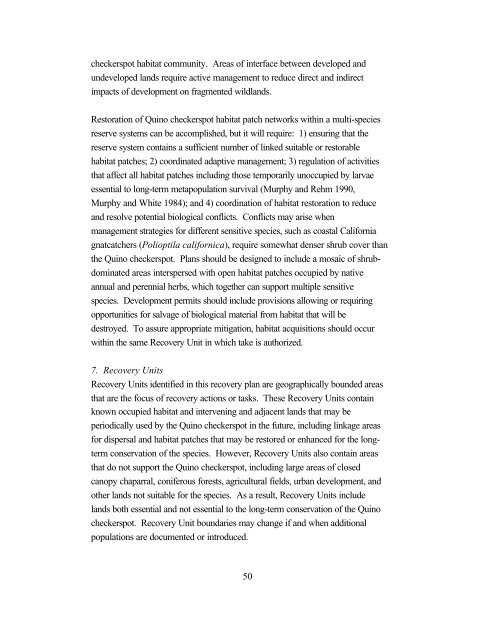Outline of Quino Recovery Plan - The Xerces Society
Outline of Quino Recovery Plan - The Xerces Society
Outline of Quino Recovery Plan - The Xerces Society
You also want an ePaper? Increase the reach of your titles
YUMPU automatically turns print PDFs into web optimized ePapers that Google loves.
checkerspot habitat community. Areas <strong>of</strong> interface between developed and<br />
undeveloped lands require active management to reduce direct and indirect<br />
impacts <strong>of</strong> development on fragmented wildlands.<br />
Restoration <strong>of</strong> <strong>Quino</strong> checkerspot habitat patch networks within a multi-species<br />
reserve systems can be accomplished, but it will require: 1) ensuring that the<br />
reserve system contains a sufficient number <strong>of</strong> linked suitable or restorable<br />
habitat patches; 2) coordinated adaptive management; 3) regulation <strong>of</strong> activities<br />
that affect all habitat patches including those temporarily unoccupied by larvae<br />
essential to long-term metapopulation survival (Murphy and Rehm 1990,<br />
Murphy and White 1984); and 4) coordination <strong>of</strong> habitat restoration to reduce<br />
and resolve potential biological conflicts. Conflicts may arise when<br />
management strategies for different sensitive species, such as coastal California<br />
gnatcatchers (Polioptila californica), require somewhat denser shrub cover than<br />
the <strong>Quino</strong> checkerspot. <strong>Plan</strong>s should be designed to include a mosaic <strong>of</strong> shrubdominated<br />
areas interspersed with open habitat patches occupied by native<br />
annual and perennial herbs, which together can support multiple sensitive<br />
species. Development permits should include provisions allowing or requiring<br />
opportunities for salvage <strong>of</strong> biological material from habitat that will be<br />
destroyed. To assure appropriate mitigation, habitat acquisitions should occur<br />
within the same <strong>Recovery</strong> Unit in which take is authorized.<br />
7. <strong>Recovery</strong> Units<br />
<strong>Recovery</strong> Units identified in this recovery plan are geographically bounded areas<br />
that are the focus <strong>of</strong> recovery actions or tasks. <strong>The</strong>se <strong>Recovery</strong> Units contain<br />
known occupied habitat and intervening and adjacent lands that may be<br />
periodically used by the <strong>Quino</strong> checkerspot in the future, including linkage areas<br />
for dispersal and habitat patches that may be restored or enhanced for the longterm<br />
conservation <strong>of</strong> the species. However, <strong>Recovery</strong> Units also contain areas<br />
that do not support the <strong>Quino</strong> checkerspot, including large areas <strong>of</strong> closed<br />
canopy chaparral, coniferous forests, agricultural fields, urban development, and<br />
other lands not suitable for the species. As a result, <strong>Recovery</strong> Units include<br />
lands both essential and not essential to the long-term conservation <strong>of</strong> the <strong>Quino</strong><br />
checkerspot. <strong>Recovery</strong> Unit boundaries may change if and when additional<br />
populations are documented or introduced.<br />
50
















